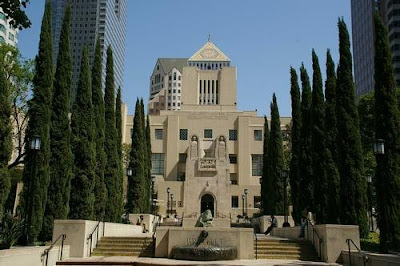





Today is the final day of our holiday to the Americas. We're in Los Angeles waiting for our flight home late tonight. So we decided to explore the city by train. Yes it is possible to travel around LA without a car, though whenever we asked someone for directions they'd say something like "Oh it's about 15 minutes down the 110 then right on the 105." Never a thought that we'd be on foot and taking public transport!!! But we've discovered that if you can work out the public transport system of a city it's by far the best way for visitors to get around.
La is a sprawling city; very flat and criss-crossed by freeways and 8 lane roads, all of which are fairly full most of the time and bumper to bumper in "rush-hour". The downtown area though was fairly quiet. We walked up Bunker Hill where all the big banks have their offices and the cultural centres are set. Disney Concert Hall is a modern structure reminiscent of the Guggenheim Museum in Bilbao. Across the road is the Museum of Contemporary Art (MOCA). We also discovered a beautiful garden hidden behind one of the big buildings on the hill. These sorts of accidental encounters are what make wandering a foreign city so fascinating. Finally we took the train to the last stop - Redondo Beach - but unfortunately it didn't quite go as far as the beach, just an industrial centre, so we didn't get to see the pacific ocean after all.
So now it's back to the real world and friends and family. We're looking forward to being in our own home and our own beds and eating "normal" food again.
See you soon!














































